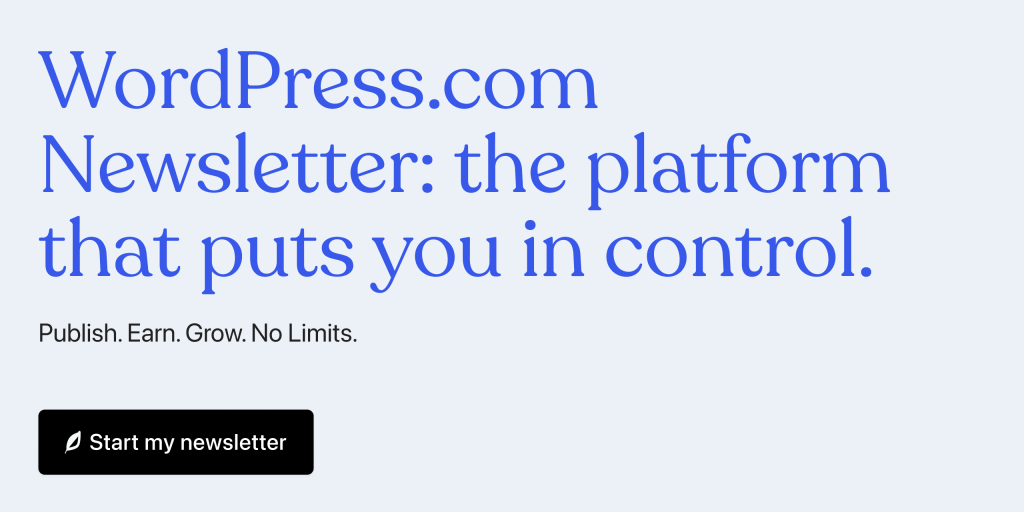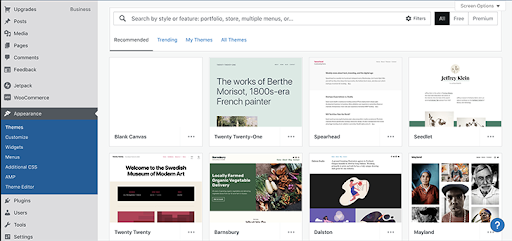If you’ve been on the hunt for a Substack alternative to host your paid newsletter, you’ve likely scoured the web to compare platforms. WordPress.com and Substack are two of the most popular options for email newsletters, but they each come with their own set of strengths and challenges. This article will compare them and highlight the differences to help you choose the best tool for your specific needs.

Read on to learn:
- More about paid newsletters and why you might need one
- What you need to know before choosing a newsletter platform
- How WordPress.com and Substack compare
What is a paid newsletter?
A paid newsletter is an informative email that your subscribers pay to receive. It’s a great way to generate recurring revenue if you consistently share valuable information with your audience.
Anyone can use a paid newsletter, but they’re instrumental if you:
- Create educational content
- Sell personalized coaching or courses
- Offer content-based memberships, like recipe libraries
- Share news updates
- Create music or other art
- Give regular financial advice
- Write about business topics
The biggest benefit of a paid newsletter is additional income that you can rely on. Since it’s subscription-based, the revenue is both predictable and less dependent on ads than other income streams.

But, of course, there are other positives. Paid newsletters are typically either free or low-cost to start — there’s very little overhead and no inventory to manage. Plus, it’s an excellent way to establish yourself as an authority in your industry. Subscribers who pay monthly for your newsletter may upgrade to higher-priced one-on-one consultations or offers.
What should you consider when choosing a newsletter tool?
Before you sit down and pick a newsletter tool, there are a few things to think about:
- Pricing and budget: How much does it cost per month? Is there a free option for a certain number of subscribers? Remember, if you plan to increase your subscription base, it’s worth starting with a strong foundation that can grow with you.
- Audience: Consider the people in your community and what they’re looking for. What kinds of functionality do they expect? How tech-savvy are they?
- Functionality: Can you integrate with the systems you’re already using? Can it accommodate needs like photo galleries, videos, or other media types? Do you want to have a members-only area where people can chat with one other? An exclusive store?
- Reader experience: The majority of email opens come from mobile devices, and that number is growing each day. But there are hundreds of devices with different operating systems, screen sizes, and more — make sure your newsletter will look great on each one.
- Newsletter goals: Think about your long-term goals. Do you want to promote or sell other products? Do you want to allow other contributors? Do you need to also develop a way to attract new subscribers? Keep in mind that paid newsletters can be the start of a much larger brand with other revenue possibilities. You want the platform you choose to fit into your goals.
WordPress.com vs. Substack
Let’s dive into a few of the factors to consider when deciding between WordPress.com and Substack.
Overview
The biggest distinguishing factor between Substack and WordPress.com is the core purpose of each one. Substack is just a blogging and paid newsletter tool — its focus is very narrow.
In contrast, WordPress.com is a website-building platform. You can create a blog and newsletter, but also expand with an eCommerce store or membership site…the sky’s the limit! You can do everything in one place, rather than piecing together a variety of tools.
Ease of use
Both Substack and WordPress.com are relatively easy to use, whether you’re a beginner or a pro.
To get started with Substack, sign up for an account by entering some basic information about yourself. You can either import an existing subscriber list or start from scratch. Then, put together your publication using simple settings and a blog system that’s similar to the word processing tools you’re already familiar with. There are just a few options for customization and, while this makes the setup process easy, it’s also very limiting.
With WordPress.com, you can create premium content after purchasing any paid plan: Personal, Premium, Business, or eCommerce. Simply create a new post and insert Premium Content blocks to define which content is part of your subscription.

You can choose between dozens of themes to find the perfect design and customize everything from colors and fonts to backgrounds and menus. Plus, use the WordPress builder to create your content, along with any additional pages that you’d like — just drag and drop buttons, images, videos, columns, and more.
Cost comparison
Substack only makes money when you do. The platform is completely free until you have paid subscribers — then they charge 10% of what you make, forever. While this setup can be beneficial at first, it does mean that you’re giving away a huge chunk of your income. The larger you grow, the more money you lose.
WordPress.com, however, doesn’t take a percentage of your profits. Instead, they charge a flat fee based on the plan that you choose. This allows you to predict exactly what you’re going to spend whether you have five subscribers or 5,000. You won’t be penalized for growth!
Unique features
What special features set these two platforms apart from one another? Let’s take a look.
Substack:
- Self-serve special offers: Substack enables you to offer free trials for premium content. For example, you might want to let people know what it would be like to subscribe for a week at no cost. This is a good way to prove your value and make more sales.
- Group subscriptions: If your audience attracts large companies, corporations, or other organizations, you can sell group subscriptions that include their team members. One administrator can manage the account and pay on behalf of everyone.
- Gift subscriptions: People can purchase subscriptions as a gift for family members and friends.
WordPress:
- Reader: WordPress.com includes the power of the Reader community to increase your reach. Your posts will be included in archives, so that people can find you when they’re searching for topics you write about. Advertising is expensive, so having this type of built-in audience is invaluable.
- Publicize: With Publicize, you can automatically share free blog posts on social media, so that people who haven’t purchased a premium subscription can get a taste of what you have to offer. This is a great marketing tool and doesn’t require any work on your end!
- The WordPress app. Create content no matter where you are, straight from your phone or tablet.
- A plugin library. With a WordPress.com plugin-enabled plan, you have access to thousands of plugins that can add functionality. There’s no limit to what you can do — build forums, market your newsletter, field subscriber questions, and more.
Flexibility
Substack is focused solely on paid newsletters. You can create content and sell it to subscribers, and that’s about it. And, while they do offer some design templates to choose from, you can’t customize them very much. It’s hard to be unique and really make your newsletter stand out.
In contrast, WordPress.com provides limitless flexibility. You can create as many pages as you’d like, sell eCommerce products, create additional memberships, host forums, and more. Build anything you’d like alongside your newsletter — the perfect setup for long-term growth. Plus, there are many more design themes to choose from and, with the drag-and-drop builder, you can customize your site to be as unique as your brand.

Scalability
Neither WordPress.com nor Substack have limits to the number of subscribers you can have. However, Substack charges 10% of each subscription, so the more subscribers, the more you pay. WordPress.com fees aren’t related to the people on your list, so you can scale without consequences.
Support
Substack has documentation available to answer common questions and walk you through setting up your subscriptions. There is also a support email for questions.
WordPress.com also has extensive documentation to help with just about anything you could imagine. There are also webinars, video tutorials, courses, and guides. Want to speak with someone? You can reach out to Happiness Engineers (the name is very fitting!) via chat or even schedule a support session via screen share.
Integrations
While Substack does include features like analytics, it doesn’t clearly integrate with any outside, third-party tools. However, you can import email lists from platforms like Mailchimp and Medium.
WordPress.com integrates with a variety of external tools. Connect to email marketing tools like Mailchimp and MailerLite. Sell event tickets with EventBrite. Book appointments with Calendly. Publish content to your social media accounts. Connect your site to Google services like analytics, email, and docs. The list goes on and on! You can build your own, fully functional business with everything you need to grow for years to come.
Content ownership
Full control of your website and business is absolutely critical for long-term success. If you decide that WordPress.com isn’t right for you, take your content anywhere you’d like! This typically isn’t possible with other platforms, like Substack.
Which newsletter platform is right for you?
When it comes down to it, the platform you choose is completely up to you. Take the time to research each one yourself and decide based on your audience, budget, needs, and long-term goals. However, we do have a couple of recommendations!
WordPress.com is right for you if:
- You want a streamlined website and newsletter experience that enables you to build a multi-faceted business with one tool.
- Creativity and customization are more important to you than simple templates.
- You want to maintain full ownership of your income stream.
- You already have a website on WordPress.com. It’s extremely easy to add a paid newsletter to an existing WordPress site.
On the other hand, Substack is right for you if:
- Your long-term goals are solely focused on a paid newsletter and don’t include things like memberships, products, or consultations.
- You want to use pre-made templates to save time rather than customize your newsletter beyond colors and logos.
- You’d rather not pay anything until you start making money and prefer a percentage-based fee rather than a flat fee.
Make a final choice
Now that you know the differences between Substack and WordPress.com, it’s time to make a decision. In summary, Substack is a good choice if you don’t want to worry about costs until you make money or just want to get started quickly without much customization.
If you’re looking for a Substack alternative, you can rest easy knowing that WordPress.com has all the tools you need to hit the ground running. You’ll have a solid foundation to work from and won’t need to worry about giving away more and more money as you grow. While there are fees to pay upfront, you’ll have full control and ownership of your business, can customize it to your heart’s content, and can grow it in a variety of ways. It’s no surprise that WordPress powers over 40% of the web.
Ready to create a paid newsletter with WordPress.com? Build your website today!
Related: How to Start a Successful Newsletter

